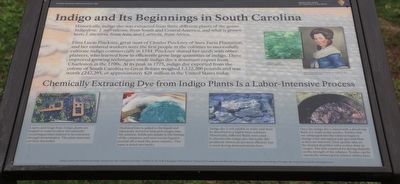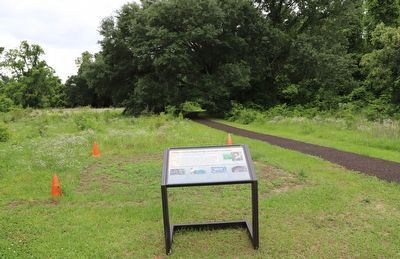Mount Pleasant in Charleston County, South Carolina — The American South (South Atlantic)
Indigo and Its Beginnings in South Carolina
Historically, indigo dye was extracted from three different plants of the genus Indigofera: I. suffruticosa, from South and Central America, and what is grown here, I. tinctoria from Asia; and I. arrecta, from Africa.
Eliza Lucas Pinckney, great-aunt of Charles Pinckney of Snee Farm Plantation, and her enslaved workers were the first people in the colonies to successfully cultivate indigo commercially in 1744. Pinckney shared her seeds with other planters, who learned how to efficiently grow large quantities of indigo. These improved growing techniques made indigo dye a dominant export from Charleston in the 1700s. At its peak in 1775, indigo dye exported from the colony of South Carolina to Great Britain weighed 1,122,200 pounds and was worth £242,295, or approximately $28 million in the United States today.
Chemically Extracting Dye from Indigo Plants Is a Labor-Intensive Process
Leaves and twigs from indigo plants are soaked in water to allow the naturally occurring protein indican to be extracted through fermentation. The plant materials are then discarded.
Hydrated lime is added to the liquid and repeatedly stirred to help pull oxygen into the solution. Solids precipitate to the bottom of the container, and once excess liquid is poured off, a mud-like paste remains. This paste is dried into bricks.
Indigo dye is not soluble in water and must be dissolved in a highly basic solution. Historically, different fluids were used to dissolve the indigo dye, but today lab-produced chemicals are most efficient. Lye is used during demonstrations here.
Once the indigo dye is mixed with a dissolving fluid, it is ready to dye textiles. Textiles that are submerged into the solution begin to change color and appear pale greenish blue as they are removed. They quickly take on the desires deep blue color as they draw in oxygen. The time required for dyeing depends on the strength of the solution. Textiles can be repeatedly submerged to achieve darker hues.
Today, nearly all commercial indigo dyeing used lab-synthesized indigo. Thanks to the staff at Kingsley Plantation in Timucuan Ecological and Historical Preserve for sharing their knowledge of indigo dye extraction and the dyeing process.
Erected by National Park Service / United States Department of the Interior.
Topics. This historical marker is listed in these topic lists: Agriculture • Horticulture & Forestry • Science & Medicine. A significant historical year for this entry is 1744.
Location. 32° 50.774′ N, 79° 49.502′ W. Marker is in Mount Pleasant, South Carolina, in Charleston County. Marker is on Long Point Road. Touch for map. Marker is at or near this postal address: 1240 Long Point Rd, Mount Pleasant SC 29464, United States of America. Touch for directions.
Other nearby markers. At least 8 other markers are within walking distance of this marker. Charles Pinckney - Statesman (within shouting distance of this marker); Snee Farm Historic Structures (within shouting distance of this marker); Snee Farm (within shouting distance of this marker); Archeology (within shouting distance of this marker); Rice Trunk (within shouting distance of this marker); Charles Pinckney (about 400 feet away, measured in a direct line); a different marker also named Charles Pinckney (about 400 feet away); Lowcountry Waterways (about 600 feet away). Touch for a list and map of all markers in Mount Pleasant.
Credits. This page was last revised on June 5, 2023. It was originally submitted on May 24, 2023, by Dave W of Co, Colorado. This page has been viewed 116 times since then and 34 times this year. Photos: 1, 2. submitted on May 24, 2023, by Dave W of Co, Colorado. • Bill Pfingsten was the editor who published this page.

